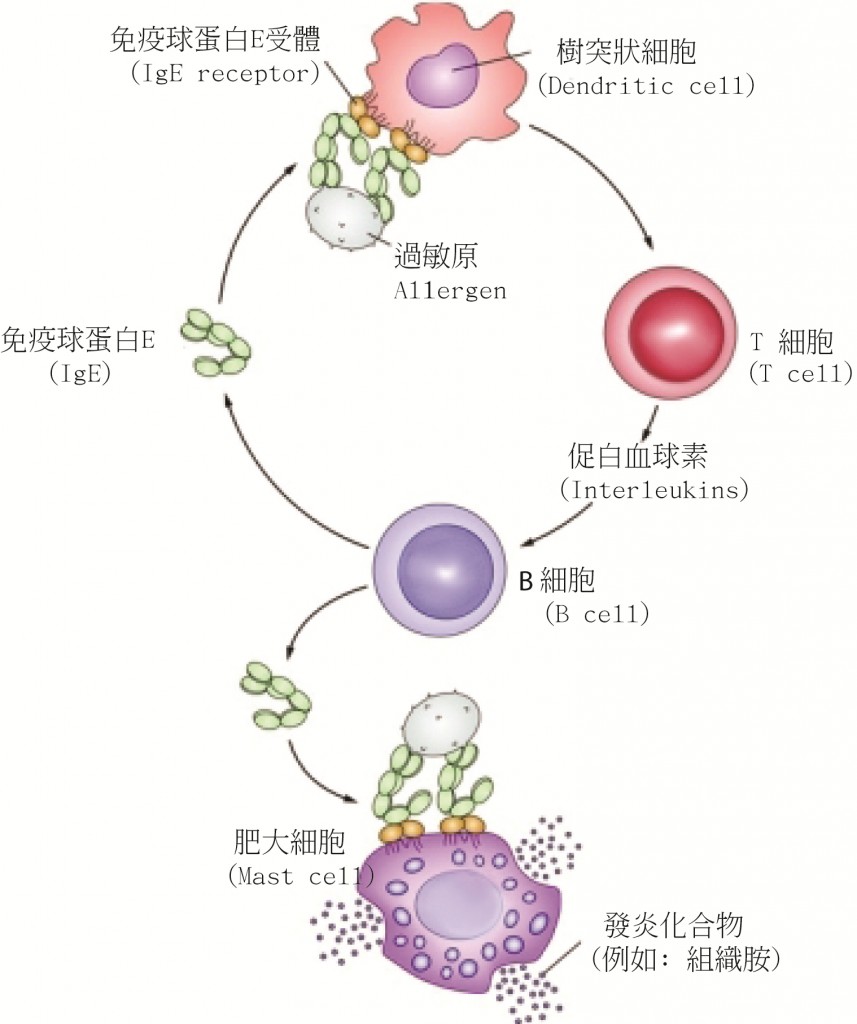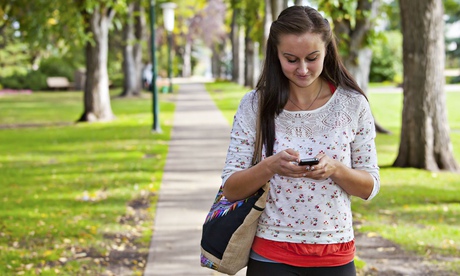Nancy Swink said that for years, students and teachers had bullied her son, blaming him for food restrictions put in place to accommodate his allergy.
“They would say, ‘It can’t be that bad,’” she said.
Chandler Swink's family is speaking out about the dangers of nut allergies...
【生物醫學】免於恐懼地吃–食物過敏的治療
■ 美國免疫學家普遍認為口服免疫療法是可行的,可以用來幫助飽受食物過敏之苦的人。

泰德.柏克里在九歲前,對雞蛋嚴重過敏。由於口服免疫療法,現在可以吃甜甜圈了。
編譯│馬千惠
在美國對特定食物有過敏反應的兒童日益增加。泰德.柏克里是在他滿九歲後第一次吃到甜甜圈,不是因為他住的地方沒有甜甜圈,也不是被禁止吃垃圾食品,而是他對甜甜圈裏所含的蛋有嚴重的過敏反應,因此不能吃。
泰德在更小的時候,只要吃到0.1%的蛋就會出蕁痲疹並且呼吸困難。所以得嚴格避免吃到蛋類製品,在學校必須坐在特定餐桌吃午餐,自備
不含蛋的蛋糕去參加生日宴會,不能吃一些他現在喜歡的食物,例如義大利麵和沾料。在滿六歲後,他的免疫專科醫師羅伯伍德邀請他參加一項在約翰霍普金斯兒童
中心進行的口服免疫治療研究,透過讓參與研究的兒童食用少量的蛋並逐漸遞增來建立身體對蛋的耐受性,最終目標是重建過敏兒童的免疫系統,使他們不需要活在
誤食蛋類製品的恐懼中。
泰德的母親對於是否參加這項測試猶豫很久,擔心測試是否會成功,是否會有反效果?泰德本身則比較樂觀,兩年多來他每天飲用添加蛋類蛋白質的柳橙汁,當他達到食用十公克蛋白質(相當於一顆蛋的量)沒有不良反應那天,他以吃甜甜圈來慶祝。
現今美國免疫學家普遍認為口服免疫療法是可行的,可以用來幫助飽受食物過敏之苦的人。包括蛋及其他會引起過敏反應的食物,例如牛奶和花生的臨床測試目前都在持續進行中。初步結果顯示這方法的可行性,不過口服免疫療法是需要很長時間,且病人本身必須承擔相當的風險,而且不見得所有病人都可
以適用,和泰德一起參加此次測試的,只有75%的人成功達到可以食用十公克蛋類蛋白質。目前並沒有真正可以治療食物過敏的方法,一般的抗過敏藥物只能減輕
症狀。現在每三分鐘就有一個人因誤食引發過敏的食物而進急診室,造成美國政府財政上的負擔,在2007年這方面的支出更高達五億美金。

免疫球蛋白 E (IgE) 引發過敏性反應的分子途徑。
免疫反應機制
免疫球蛋白E (IgE)
在啟動過敏反應中扮演主要的角色。當過敏原(Allergen)首次進入身體時,樹突狀細胞(一般分佈在皮膚和黏膜)上的免疫球蛋白E會結合過敏原,啟動
T細胞分泌促白血球素(Interleukins),刺激B細胞製造對該過敏原有特異性的免疫球蛋白E,新形成有特異性的免疫球蛋白E會鑲嵌在肥大細胞
(Mast cell)和嗜鹼性白血球表面,等待再次接觸特定的過敏原。當過敏原結合到肥大細胞(Mast cell)
上的免疫球蛋白E時,發炎物質會被釋放出來,引發流鼻涕,搔癢,紅腫,腹瀉甚至嘔吐等過敏反應。
泰德的免疫專科醫師羅伯伍德指出,雖然每個人的過敏症狀都不盡相同,但不管是對特定食物過敏,花粉熱或是氣喘,在體內分子層次上的作用機制都相同。
科學家們企圖以此免疫反應機制中的各個環節,研發不同的方式來治療食物過敏。以更有效的方式來幫助對食物過敏的人(在美國地區,十八歲
以下的人中,每十三個就有一個有食物過敏問題)
。免疫球蛋白E是啟動過敏反應的關鍵,因此許多研發藥物以此為標的。倫敦大學國王學院的化學家和生物物理學家布萊恩 J.
薩頓指出免疫球蛋白E最顯著的特性是它可以引起強大的過敏反應。
目前市面上有對抗免疫球蛋白E的抗體藥物,是台灣中研院研究員張子文所提出抗免疫球蛋白E抗體的概念研發出,由基因科技公司
Genentech和Novartis所共同推出市面的Xolair,這是一種設計來清除人體裡面游離型免疫球蛋白E的單株抗體。原始的抗體有可能因為結
合到鑲嵌在肥大細胞(Mast
cell)和嗜鹼性白血球表面的免疫球蛋白E,引發過敏反應而危及生命,所以他在1989年提出這個想法時受到很大的質疑,他致力於證明此單株抗體只會結
合游離型的免疫球蛋白E,而不會影響鑲嵌型,確認其安全性。他成立生化製藥公司 Tanox,同時尋找合作夥伴來進行抗免疫球蛋白E計畫。經過和
Novartis合作及一些臨床測試,最終由 Genentech在2007年買下
Tanox。雖然Tanox已不存在,但抗免疫球蛋白E的抗體藥物概念以
Xolair的形式存在,並於2003年得到美國食品及和藥物管理局(FDA)的認證,可用於有嚴重持續性氣喘的病人身上。目前有超過一百種注射性治療的
藥物在臨床測試的階段,包括一些治療慢性蕁麻疹和濕疹的藥物。Xolair
在有關食物過敏上比較沒有進展,因為進行臨床測試時,有些病人對於注射抗體藥物 Xolair
前所需先服用的測試劑量花生就有很強的過敏反應,因其風險性使得臨床測試被迫停止。
但是在停止臨床測試前,一些已完成測試程序的病人有不錯的反應,他們血液中的免疫球蛋白E在注射 Xolair後,有顯著的下降。平均來說,對花生所含蛋白質的耐受性比接受 placebo治療的高。
所以研究人員嘗試結合 Xolair和口服免疫療法,治療對牛奶和花生的過敏的病人,目前已在進行第一期和第二期的臨床試驗。Xolair的專利在2017年到期後,價格會由現在每年八千到兩萬元美金下降,一旦通過臨床試驗,對食物過敏的病人將能受惠。

免疫球蛋白E結構圖,顯示出其幹狀部份結合至受體上。
當免疫球蛋白E結合到細胞膜上的受體 (receptor)時,幹狀部份的彎曲會更顯著,使得指狀結構可以更容易和過敏原結合。
薩頓表示即使如此,抗免疫球蛋白E的抗體治療法並不適用於所有人,體型較大或體內的游離型免疫球蛋白E濃度較高的病人並不能用此藥物。因為劑量上的限制,醫生不能施打足夠量的Xolair 以清除體內游離的免疫球蛋白E。
所以薩頓和張子文都在尋找不同的策略。張子文在1990年,提出研發抗體是以位在B淋巴球膜上具特異性的免疫球蛋白E為目標。一旦抑制
這些B淋巴球膜,就可以阻斷免疫球蛋白E的生成途徑,此策略的潛在優勢是所需要的抗體量比較少,不須頻繁的注射。這樣病人的體重或體內的游離免疫球蛋白E
濃度高低,就沒有關係。免疫球蛋白E不會快速再生,而此一途徑也會終止數個月。Genentech公司也研發這種類型的抗體,稱為quilizumab。
該公司還沒有在食物過敏症患者身上測試它,目前是用於治療氣喘。
薩頓則是專注於研發結合免疫球蛋白E的小分子藥物,以口服方式降低成本。有些人試圖直接阻斷免疫球蛋白E結合到分佈於肥大細胞和和嗜鹼
性白血球表面的受體。因為其作用是在相對來講非常大的表面,且免疫球蛋白E結合受體的強度又比一般抗體與其受體結合強一千倍,因此都沒能成功。薩頓認為小
分子不可能直接阻斷這強大的結合,去年他的研究團隊以X-射線分析晶體結構技術,定出免疫球蛋白E結合膜外受體的蛋白質結構,確認免疫球蛋白E是以其Y型
結構的幹狀部位結合受體,且幹狀部份的結構會改變,彎曲得更顯著,因此他們的策略是以小分子結合免疫球蛋白E,使它的結構無法改變,不能結合其受體。經由
篩選試驗,他們找到一些小分子,但是先要確定小分子結合免疫球蛋白E的部位再發表。
並非所有過敏藥物的研究重點都是免疫球蛋白E。一些科學家則針對過敏反應途徑的其他部分進行研究。還有一些人認為,過敏性疾病太複雜,
無法單純針對一個分子解決問題。另外有些研究員則質疑只使用單種藥物做治療,例如Xolair,只能暫時解決症狀,一旦停止使用症狀又會出現。
北卡羅萊納州大學醫學院兒科過敏和免疫學的伯克斯認為口服免疫療法有機會修改疾病。研究人員發現治療會改變患者的免疫系統。他們體內的
免疫球蛋白G (IgG) 會提高而免疫球蛋白E則下降,肥大細胞和嗜鹼性白血球變得不那麼活躍。但是研究人員還是無法理解為什麼只在有些病人有效。
泰德.
柏克里所參與的口服免疫治療測試,只有少數幾個人真正成功。當他們達到十公克的蛋類蛋白質測試量後,即停止吃蛋四到六週,然後回到研究中心做最終測試。只
有28%的受試者仍舊可以吃多量的蛋而不產生過敏反應,泰德不幸的也屬於失敗的案例,在長達兩年的治療後,僅僅很短的時間就失去對蛋的耐受性。所以為了維
持他免疫系統建立的耐受性,必須在飲食中持續維持基本量的蛋,他每週至少得吃兩次蛋。雖然口服免疫治療尚未完全成功,但許多人尤其是患者的父母們還是樂見
耐受性能夠提高,如此即使不小心吃到含有少量過敏原的食物時,不至於有強烈的過敏反應,可以有多一層安全保護。不過口服免疫治療法必須在醫師的監督下進
行,不可自行嚐試。
隨著科學的進步,我們對免疫系統的耐受性有更多的瞭解,相信會有更好的策略來治療食物過敏。至少泰德透過治療終於可以嚐到各種甜甜圈!
*****
主旨:
雞蛋的吃法
|
你知道這麼吃雞蛋是有毒的嗎?想不到吧?平時經常吃的東西居然會變成毒藥,
如果你還在用這些錯誤的方法吃雞蛋,那麼,你可要注意了!
雞蛋是天然食物中,富含大量的維生素和礦物質及有高生物價值的蛋白質。是人類最好的營養補品之一 。相信不用我介紹,大家都知道雞蛋的營養價值!
總的來說,雞蛋的功效可以概括為,健腦、延年、益智、保護肝臟以及防治動脈硬化等疾病,還有就是預防癌症。
但是你知道嗎?用錯誤的方法吃雞蛋,這麼好的營養品就會變成毒品!
下面的幾種方法就是吃雞蛋的錯誤方法,比對一下,看看你平時有沒有用正確的方法吃雞蛋!不對的話,要馬上更正過來哦!
1.生吃
有些人覺得,食物 一 經煮熟,就會流失其營養價值。所以很多人喜歡生吃蔬菜、生吃海鮮。同樣,有人認為生吃雞蛋可以獲取比熟雞蛋更多的營養價值。但是,其實不然,生吃雞蛋很可能會把雞蛋中含有的細菌(例如大腸桿菌)吃進肚子去,造成腸胃不適並引起腹瀉。並且,值得 一 說的是,雞蛋的蛋白含有抗生物素蛋白,需要高溫加熱破壞,否則會影響食物中生物素的吸收,使身體出現食欲不振、全身無力、肌肉疼痛、皮膚發炎、脫眉等症狀。
2.隔夜
雞蛋其實是可以煮熟了之後 ,隔天再重新加熱再吃的。但是,半生熟的雞蛋,在隔夜了之後吃卻不行!雞蛋如果沒有完全熟透,在保存不當的情形下容易滋生細菌,如造成腸胃不適、脹氣 等情形。
同時,有的人認為雞蛋煮越久越好,這也是錯誤的。因為雞蛋煮的時間過長,蛋黃中的亞鐵離子與蛋白中的硫離子化合生成難溶的硫化亞鐵,很難被吸收。油煎雞蛋過老,邊緣會被烤焦,雞蛋清所含的高分子蛋白質會變成低分子氨基酸,! 這種氨基酸在高溫下常可形成對人體健康不利的化學物質。
3.過量
如大家所知,雞蛋含有高蛋白,如果食用過多,可導致代謝產物增多,同時也增加腎臟的負擔,造成腎臟機能的損傷。所以一般老年人每天吃1~2個雞蛋為宜。中青年人、從事腦力勞動或輕體力勞動者,每天可吃2個雞蛋;從事重體力勞動,消耗營養較多者,每天可吃2~3個雞蛋;少年兒童由於長身體,代謝快,每天也應吃2~3個雞蛋。孕婦、產婦、乳母、身體虛弱者以及進行大手術後恢復期的病人,需要多增加優良蛋白質,每天可吃3~4個雞蛋,但不宜再多。
4.加糖、加豆漿
很多人喜歡在烹煮各種食物的時候將雞蛋跟糖一起煮。其實雞蛋與糖一起烹飪,二者之間會因高溫作用生成一種叫糖基賴氨酸的物質,破壞了雞蛋中對人體有益的氨基酸成分。值得注意的是,糖基賴氨酸有凝血作用,進入人體後會造成危害。所以應當等雞制食物冷了之後再加入糖。
另外有很多人喜歡在早餐的時候吃上一個雞蛋一個麵包,再加上一杯豆漿。其實大豆中含有的胰蛋白酶,與蛋清中的卵松蛋白相結合,會造成營養成分的損失,降低二 者的營養價值。
5、空腹吃雞蛋
空腹吃雞蛋不是很好,空腹過量進食 牛奶 、豆漿、雞蛋、肉類等蛋白質含量高的食品,蛋白質將“被迫”轉化為熱能消耗掉,起不到營養滋補作用。同時,在一 個較短的時間內,蛋白質過量積聚在一起,蛋白質分解過程中會產生大量尿素、氨類等有害物質,不利於身體健康.
6.煎雞蛋、茶葉蛋
有很多人喜歡吃煎雞蛋,特別是邊緣煎得金黃的那種,這個時候就要注意啦,因為被烤焦的邊緣,雞蛋清所含的高分子蛋白質會變成低分子氨基酸,這種氨基酸在高溫下常可形成致癌的化學物質。另外,茶葉蛋也應少吃,一 來是因為茶葉蛋反復的煎煮,其營養已經被破壞,另一方面就是在這個過程中茶葉中含酸化物質,與雞蛋中的鐵元素結合,對胃起刺激作用,影響胃腸的消化功能。
看來,吃一個小小的雞蛋所要注意的還真多,但是這都是些值得注意的tips。只要我們平時在吃的時候注意一點,就能夠很好地吸收雞蛋中有益的
|














